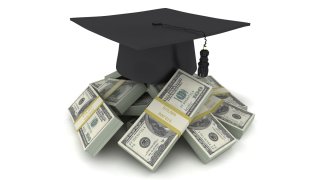
What to Know
- Student loan debt totals more than $1.6 trillion and is not shrinking as few borrowers have reduced their balances, according to Moody’s
- The issue has been a cornerstone of some presidential candidates’ campaigns
- High student loan balances are having multiple negative economic effects, such as restricting household formation, Moody’s said
The rapid increase of student loan debt has slowed over the past few years, but individual borrower balances aren’t going down mostly because hardly anybody is paying down their loans.
Total indebtedness over the past year or so has stopped its meteoric rise, according to a study that Moody’s Investors Service released Thursday. Nevertheless, the study showed a number of factors are constraining borrowers from lightening their loads. Outstanding loans total more than $1.6 trillion, more than doubling over the last decade and tripling since 2006.
Since the explosion of student debt following the Great Recession, annual repayment rates, or the amount of existing balances lowered, have been just 3%, Moody’s said. Just 51% of borrowers who took out loans from 2010-12 have made any progress at all in paying down their debt.
“While in the past, higher enrollment and rising tuition were the main drivers of growing student loan balances, more recently, slow repayments have become the primary driver,” Jody Shenn, senior analyst at Moody’s, and others said in the report. “Over the next few years, the combination of slow repayments and elevated, if no longer growing, levels of new borrowing will likely fuel further increases in outstanding debt.”
High default rate
U.S. & World
There are multiple reasons why the debt levels are not going down.
One is that many borrowers are taking advantage of repayment plans based on borrowers’ incomes, along with some opting for longer repayment options.
Presidential candidates, particularly on the Democratic side, have made reducing or eliminating student debt cornerstones of their campaigns. Moody’s said those kinds of proposals “would stimulate the US economy but have negative effects for some financial institutions.”
In the meantime, the burden of student loans continues to be felt with an 11% default rate that is the highest of any debt category. Education also is now second only to mortgages as the highest form of debt for all Americans.
“Increased reliance on student debt crowds out an individual’s access to other forms of household credit, which likely delays business formation and homeownership, important drivers of economic growth and wealth creation,” Shenn wrote.
One indication that the pressure may alleviate if only a bit is that the annual growth rate decelerated to 5% in the third quarter of 2019, down from the peak of 14.7% at the end of 2008, according to the Federal Reserve.
A paper released earlier this week from the St. Louis Fed also looked at the student debt issue. The research noted that debt has grown more rapidly for students in four-year and graduate schools as opposed to community colleges, hinting that repayment rates could accelerate in the future.
This story first appeared on CNBC. More from CNBC:



